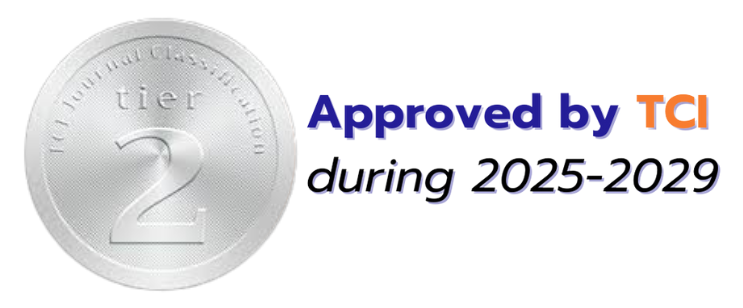ตัวแบบปัจจัยเชิงสาเหตุที่ส่งผลต่อการจัดการเรียนรู้ของครู โรงเรียนในสังกัดสำนักงานเขตพื้นที่การศึกษามัธยมศึกษานครปฐม
DOI:
https://doi.org/10.56825/jehds.2025.916037คำสำคัญ:
สภาพแวดล้อมในโรงเรียน, วัฒนธรรมองค์การ, การรู้ดิจิทัล, การจัดการเรียนรู้ของครู, สมการโครงสร้างบทคัดย่อ
การวิจัยนี้มีวัตถุประสงค์เพื่อ 1) ศึกษาตัวแบบปัจจัยเชิงสาเหตุที่ส่งผลต่อการจัดการเรียนรู้ของครู โรงเรียนในสังกัดสำนักงานเขตพื้นที่การศึกษามัธยมศึกษานครปฐม และ 2) ศึกษาแนวทางการส่งเสริมการจัดการเรียนรู้ของครู โรงเรียนในสังกัดสำนักงานเขตพื้นที่การศึกษามัธยมศึกษานครปฐม กลุ่มตัวอย่าง คือ ครูผู้สอนโรงเรียนในสังกัดสำนักงานเขตพื้นที่การศึกษามัธยมศึกษานครปฐม จำนวน 342 คน และผู้ให้ข้อมูลหลัก จำนวน 5 คน ใช้วิธีการสุ่มตัวอย่างแบบแบ่งกลุ่ม (Cluster Random Sampling) โดยใช้การเชิงปริมาณและเชิงคุณภาพ เครื่องมือที่ใช้ในการวิจัย คือ แบบสอบถามและแบบสัมภาษณ์ การวิเคราะห์ข้อมูลเชิงปริมาณใช้สถิติเชิงพรรณา วิเคราะห์ตัวแบบสมการโครงสร้างแบบ PLS-SEM และการวิเคราะห์ข้อมูลเชิงคุณภาพโดยใช้การวิเคราะห์และการสังเคราะห์เนื้อหา
ผลการวิจัยพบว่า
1) สภาพแวดล้อมในโรงเรียนมีอิทธิพลทางบวกต่อการรู้ดิจิทัลและมีอิทธิพลทางอ้อมต่อการจัดการเรียนรู้ของครู อย่างมีนัยสำคัญทางสถิติที่ระดับ .05วัฒนธรรมองค์การมีอิทธิพลทางบวกต่อการรู้ดิจิทัล และมีอิทธิพลทางอ้อมต่อการจัดการเรียนรู้ของครู อย่างมีนัยสำคัญทางสถิติที่ระดับ .05 และการรู้ดิจิทัลมีอิทธิพลทางบวกต่อการจัดการเรียนรู้ของครู อย่างมีนัยสำคัญทางสถิติที่ระดับ .05
2) แนวทางการส่งเสริมการจัดการเรียนรู้ของครู พบว่า 2.1) สภาพแวดล้อมในโรงเรียนควรเน้นความปลอดภัยทางกายและใจ สร้างบรรยากาศที่ส่งเสริมความสามารถและสมรรถนะของนักเรียนในการพัฒนาตนเอง 2.2) วัฒนธรรมองค์การในโรงเรียนควรได้รับการสนับสนุนที่ดีจากผู้บริหาร มีความยืดหยุ่น ทำงานร่วมกัน สร้างสรรค์นวัตกรรมในโรงเรียน และพัฒนาศักยภาพของบุคลากรอย่างเต็มที่ 2.3) ดิจิทัลเพื่อการเรียนรู้ควรเน้นการเรียนแบบโต้ตอบ พัฒนาครูให้มีทักษะ ความเข้าใจ และความสามารถในการใช้เทคโนโลยีในการจัดการเรียนรู้ (Digital Literacy) และ 2.4) หลักสูตรสถานศึกษาควรเน้นบูรณาการเนื้อหา ใช้เทคโนโลยี พัฒนาทักษะชีวิต มีการปรับปรุงอย่างต่อเนื่อง และควรมีการวัดผลที่หลากหลายเพื่อสร้างแรงจูงใจการเรียนรู้
Downloads
เอกสารอ้างอิง
Bangmo, S. (2015). Organization and management (6th ed.). Wittayapat Company Limited. [translated]
Blumer, V., Kanwar, M. K., Barnett, C. F., Cowger, J. A., Damluji, A. A., Farr, M., Goodlin, S. J., Katz, J. N., McIlvennan, C. K., Sinha, S. S., & Wang, T. Y. (2024). Cardiogenic shock in older adults: A focus on age-associated risks and approach to management. Circulation, 149(14), e1051-e1065.
Bunprod, S., Sriputtarin, S., Kheawnamchum, J. (2020). The development of guidelines for organizing laerning environment in schools under the Secondary Educational Service Area Office 22 in Nakhon Phanom Province. Journal of Educational Administration and Supervision: Mahasarakham University, 11(3), 17-27. [translated]
Butket, W. (2019). Organizational culture and happy workplace of teachers in school under the Secondary Educational Service Area Office 9 (Master’s thesis, Silpakorn University). [translated]
Inthraphu, E. & Wanphirun, P. (2021). Smart digital learning environment to promote teacher professional experience training. Journal of Industrial Education, King Mongkut's University of Technology North Bangkok, 12(1), 193-204. [translated]
Khlaisri, P. (2017). Development of the instructional model using blended learning and metacognition
for Faculty of Education students in Rajabhat University in the Northeastern (Doctoral dissertation, Dhurakij Pundit University). [translated]
Khudadad, N., & Mickelson, R. A. (2021). School built environment, gender and student achievement in Pakistan. International Journal of Educational Development, 87, 102503.
Lowpasee, T. & Sanglertuthai, C. (2017). Organizational culture affecting the competence of teachers according to the knowledge standards in educational institutions under the Office of the Primary Educational Service Area 1, Nakhon Pathom. Journal of Silpakorn Educational Research, 9(1), 286-298. [translated]
Maslov, Y., Pypenko, I., & Melnyk, Y. (2021). The impact of COVID pandemic consequences on public demand for competence formation in humanitarian education. Rupkatha Journal on Interdisciplinary Studies in Humanities, 12(5), 1-7.
Mohammed, A. B., Zegeye, R. T., Dawed, H. A., & Tessema, Y. M. (2024). Implementation of problem-based learning in undergraduate medical education in Ethiopia: An exploratory qualitative study. Adv Med Educ Pract, 15, 105-119.
Nakhon Pathom Secondary Educational Service Area Office. (2023). Vision/Mission. https://shorturl.asia/TGyi4 [translated]
National Digital Economy and Society Commission. (2018). Policy and planning for development. https://www.onde.go.th/view/1/main/TH-TH [translated]
Office of the National Economic and Social Development Council. (2022). The thirteenth national economic and social development plan 2023 - 2027. https://www.nesdc.go.th/nesdb_en/more_news.php?cid=346&filename=index [translated]
Paetsch, J., Franz, S., & Wolter, I. (2023). Changes in early career teachers' technology use for teaching: The roles of teacher self-efficacy, ICT literacy, and experience during COVID-19 school closure. Teaching and Teacher Education, 135, 1-11.
Preechanonth, S. (2021). The development of a cloud-based blended learning model using synectics approach and lateral thinking technique to enhance photography creative problem solving ability for Rajabhat University students (Doctoral dissertation, Silpakorn University). [translated]
Rumeit, S. (2022). Needs and guidelines for promoting the competency of guidance teachers under the Secondary Educational Service Area Office Kamphangphet (Master’s thesis, Naresuan University) [translated]
Sa-u, N. (2021). Learning development in digital era: Framework toward SDGs. Electronic Journal of Open and Distance Innovative Learning (e-JODIL), 11(2), 19-29.
Sirisak, K. (2016). Curriculum research on teacher education program for developing digital competence enhancement guidance (Master’s thesis, Chulalongkorn University). [translated]
Soper, D. (2024). A-priori Sample Size Calculator for Structural Equation Models. https://www.danielsoper.com/statcalc/
Srichan, P. (2019). A study of digital learning environment to develop digital literacy skills of students: A case study of Uttaradit Rajabhat University. Journal of Information and Technology, 3(2),
-15. [translated]
Srisom, P. & Limpapat, P. (2023). Guidelines for developing digital leadership characteristics of teachers under the Office of the Primary Educational Service Area, Pathum Thani Area 1. The Journal of Research and Academics, 6(3), 93-108. [translated]
Thanomton, C. (2018). A causal model of transformational leadership and school environments through basic psychological needs affecting teachers’ engagement in professional learning in schools under the Bangkok Metropolitan Administration (Doctoral dissertation, Kasetsart University). [translated]
The Government Public Relations Department. (2020). Public relations department's operational plan 2020-2037 and 3-year term (2020-2022) complete edition. https://law.prd.go.th/th/content/page/index/id/35 [translated]
Xianhan, H., Lin, C.H., Sun, M., & Xu, P. (2021). What drives teaching for creativity? dynamic componential modeling of the school environment, teacher enthusiasm and metacognition. Teaching and Teacher Education, 10(7), 112-125.
Zhao, W. (2024). A study of the impact of the new digital devide on the ICT competences of rural and urban secondary school teachers in China. Heliyon, 10, 1-12.
ดาวน์โหลด
เผยแพร่แล้ว
ฉบับ
บท
การอนุญาต
ลิขสิทธิ์ (c) 2025 วารสารศาสตร์การศึกษาและการพัฒนามนุษย์

This work is licensed under a Creative Commons Attribution-NonCommercial-NoDerivatives 4.0 International License.







